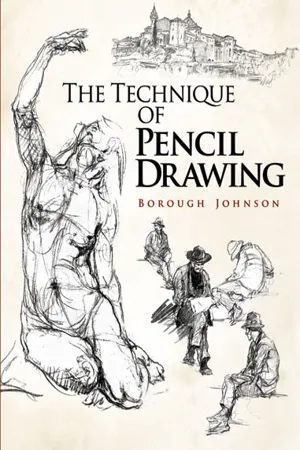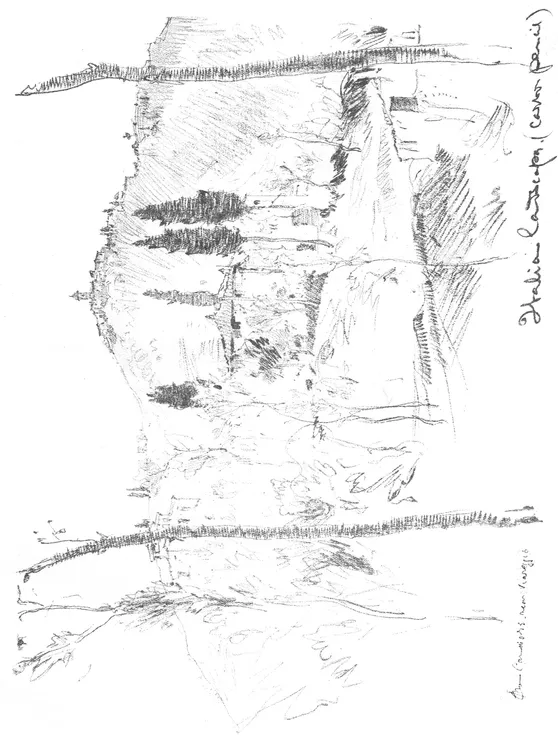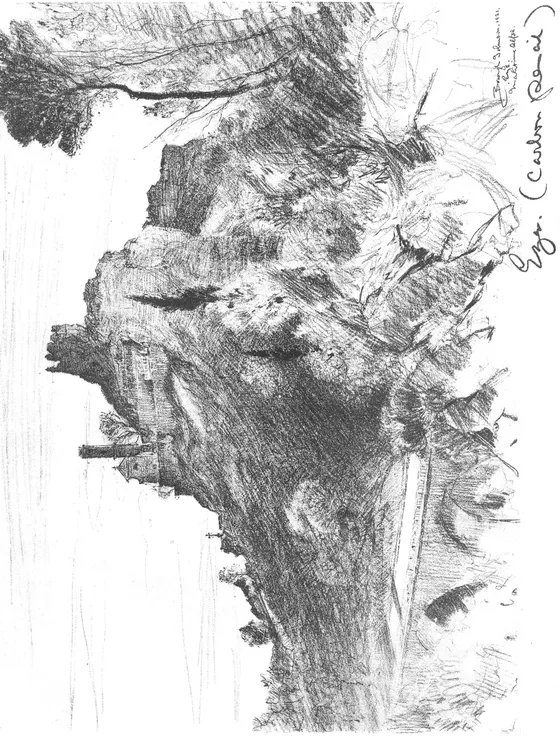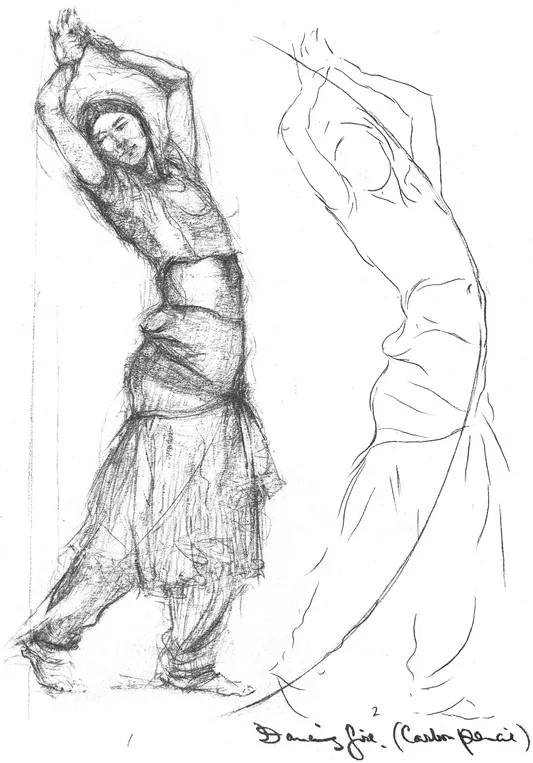
This is a test
- 160 pages
- English
- ePUB (mobile friendly)
- Available on iOS & Android
eBook - ePub
The Technique of Pencil Drawing
Book details
Book preview
Table of contents
Citations
About This Book
Only a thoroughly accomplished artist such as Borough Johnson—a nineteenth-century landscape and genre painter—could manage to illuminate the technique of pencil drawing in these exquisitely simple terms. Artists at every level of experience will appreciate the wealth of information he offers on everything from choosing the right tools to drawing the nude figure. With a host of helpful `how-to` illustrations, as well as a `mini-gallery` of finished compositions, this invaluable guide offers clear direction for artists who want to learn to draw—or sharpen their skills.
Johnson starts with the basics, explaining how to hold a pencil for the greatest control, how to select the right paper, and how to add shading and tone for the best results. `The range of effects is infinite,` he affirms. Moving outdoors, he tackles landscapes, seascapes, and other scenery, demonstrating where to start your sketch and where to leave off. When drawing the nude figure, he suggests quick poses to capture body structure and balance before adding detail. Best of all, Johnson explores the importance of individuality in each artist and how each one's expression should be absolutely unique. When you see the magnificent artwork included—from stunning portraits of dancers and fishermen to splendid scenes in Venice and Pisa—you'll be inspired to master this expressive art form.
Johnson starts with the basics, explaining how to hold a pencil for the greatest control, how to select the right paper, and how to add shading and tone for the best results. `The range of effects is infinite,` he affirms. Moving outdoors, he tackles landscapes, seascapes, and other scenery, demonstrating where to start your sketch and where to leave off. When drawing the nude figure, he suggests quick poses to capture body structure and balance before adding detail. Best of all, Johnson explores the importance of individuality in each artist and how each one's expression should be absolutely unique. When you see the magnificent artwork included—from stunning portraits of dancers and fishermen to splendid scenes in Venice and Pisa—you'll be inspired to master this expressive art form.
Frequently asked questions
At the moment all of our mobile-responsive ePub books are available to download via the app. Most of our PDFs are also available to download and we're working on making the final remaining ones downloadable now. Learn more here.
Both plans give you full access to the library and all of Perlego’s features. The only differences are the price and subscription period: With the annual plan you’ll save around 30% compared to 12 months on the monthly plan.
We are an online textbook subscription service, where you can get access to an entire online library for less than the price of a single book per month. With over 1 million books across 1000+ topics, we’ve got you covered! Learn more here.
Look out for the read-aloud symbol on your next book to see if you can listen to it. The read-aloud tool reads text aloud for you, highlighting the text as it is being read. You can pause it, speed it up and slow it down. Learn more here.
Yes, you can access The Technique of Pencil Drawing by Borough Johnson in PDF and/or ePUB format, as well as other popular books in Art & Art Techniques. We have over one million books available in our catalogue for you to explore.
Information
Topic
ArtSubtopic
Art TechniquesTHE TECHNIQUE OF PENCIL DRAWING
CHAPTER I
The Correct Method of Holding the Pencil, the way to Cut it, and the Suitability of Papers
FOR the method I employ it is important to select the right degree and make of lead pencil, for there are so many shades, from very hard to soft lead. I myself generally use a first-grade quality BB, with which degree practically all the drawings in lead reproduced in this book have been executed. The first two illustrations demonstrate the wide range of shades, from the palest grey to deep black, according to the pressure used. The chromatic scale of shading as shown was done with only one cutting of a BB pencil, held in the right manner, on suitable paper. I use the word “ chromatic,” believing that black and white can, in a sense, suggest colour.
The pencil should be held, as shown in Plate III, Fig. 3, between the thumb and the first two fingers ; or, if the pencil is long enough, between the thumb and index finger, but running through the third and little finger, as illustrated in Plate III, Fig. 4. In this way one has great control over the pencil, can keep the edge of the lead point parallel to the paper, and be able to apply pressure of the thumb where necessary in darker tones or decisive touches, all the control coming from the finger tips, in harmony with a flexible wrist. If this method is employed, it is possible, with considerable practice, to render every degree of gradation from the faintest to the deepest shades, with any shape, size or touch, much as a brush can do. The range of effects is infinite ; in fact, this method of pencil drawing or painting is akin to brushwork, as we may see in Frans Hals’ portraits, and requires keenness of vision with certainty of touch and tone. The beginner should frequently practise the necessary pressure or touch required to mark the scale of tones and shapes he may need in this most difficult of all ways of modelling with the pencil.
Now the cutting of the pencil is important, very important indeed, in order to obtain the number of touches and tones necessary in such a drawing as that of the man’s head shown in Plate XV. One must make the lead point last as long as possible to avoid hindrance in re-cutting, and to do this the lead must be supported by the wood on the side not employed, but cut away to expose the facets of the lead used, as in diagrams A, B, C, in Plate II, so as to obtain narrow or broad touches.
One must have a sharp penknife, and hold the pencil firmly in the left hand towards the top whilst cutting.
There are many kinds of papers, and it is interesting to experiment with different surfaces and qualities, but for general use I find a smooth machine-made demy paper the best, such as chemists use for wrapping up bottles, etc. The only disadvantages this paper has are thinness and liability to change of colour under light. Otherwise it is perfect, and gives beautiful qualities in the blacks. Use the smooth side without the grain. Then I have used stouter paper, such as cartridge, and any hot-pressed paper. Bristol board is also suitable.

PLATE I

PLATE II

PLATE III

PLATE IV
If the paper is thin, it is advisable to work over several sheets placed under the drawing in order to give elasticity to the touch, which materially aids one in securing delicacy and subtlety of modelling and good quality in the blacks.
As to rubber, the less used the better. From the commencement endeavour to avoid rubbing out. Employ it for drawing ; for this it is often invaluable. The rubber of a putty consistency is the best ; it easily lifts the lead, and is easily moulded with the fingers to a point which can be used for cutting out shapes and high lights.
CHAPTER II
The Commencement of a Drawing and the Value of a Rapid and Essential Outline
WHEN I speak of outline I mean all that depicts form without tone, that is to say, even a few dots and short strokes suggesting features with their main expressions as we see so wonderfully done in the sketches of Rembrandt, and of Forain, who with a few deft touches tells his story so vividly. So outline comprises the smaller inner forms and features as well as the larger contours. To show my meaning more clearly I have drawn the principal lines of a nun’s face, showing the expression characteristic of grief, the first three outlines retaining the emotion, the fourth reduced to the merest essentials.
If we study the muscles of the face with their mechanism relative to the conditions controlling the emotions, we find they all conform to precise rules and reasonings and show that each passion has a distinct line of direction. For instance, the opposite of sorrow is laughter, in which the lines of the mouth and nostrils rise upwards with the eyes horizontal, so it is quite possible to represent each mood with a few simple strokes, provided we give them the right characteristic direction (Plate IV). To do this we must understand the anatomy of expression, which all portraitists who make a study of physiognomy do. Expression does not lie solely in the features but in the attitude of the body and its separate parts, particularly in the hands, which are more often than not neglected.
Anyone with ordinary intelligence and application can learn to sketch more or less “ correctly,” provided he has a capable master continually at his elbow to point out his mistakes; for to see proportions, facts and forms scientifically needs much practice and experience. To observe with an artist’s eye is another matter altogether, and is a gift which only the aesthetic soul can possess.
My aim in this book is to combine the two essentials ; and I hope to show in this chapter the importance to the inexperienced of the first few lines in starting a drawing. Be the subject an object, landscape, architecture, face or figure, our first general impression is its shape, masses, and principal lines of design, and not its detail, but its form, to be rendered by an outline, which of course has no existence in fact, but is the easiest means of expressing our ideas. To put down that nonexistent line in as simple a manner as possible is our first consideration, be the draughtsman a beginner or an artist of experience.
The child with his hazy notion of form, and the savage with his wider knowledge of life and Nature, record their impressions with a sharp point in outline, thus expressing in the simplest manner the things they have seen or their fancy imagined. Drawing is practically all memory, from the momentary to the longer retained image.
The cultivation of the memory is much neglected in art teaching, where only too often art education is repressive of personal initiative and individuality, art deadening instead of being vital and inspiring. What we need is more the teaching of Lecoq de Boisbaudran, where memory played such a great part, and whose school in Paris in the middle of the last century was productive of such excellent results. We have only to study the prints and drawings by Japanese artists of the eighteenth and nineteenth centuries to see what cultivation of the memory can effect. Look at the drawings of the late Joseph Crawhall, who was a genius in this respect, and François Millet, who seldom worked directly from Nature, except in his student days, for the reason, as he said, that “ Nature does not pose.”
The art of drawing from life and Nature is not a convention of imitating all one sees, but should be a simple and searching statement of essential facts and solid forms, for the whole is greater than its parts.
The contour of a nude figure, the outline of any object, if drawn with artistic understanding, can convey an impression of three dimensions, or solidity, as well as a shaded drawing. By this I mean not a continuous, unvarying line, with no suggestion of light and shade, and lost and sharp edges, but one stating the sense of vision with that of touch. This may sound impossible to the beginner, but as he progresses the truth of this statement will, I hope, be proved.
If we draw an egg against a white ground, in pure outline, as shown in the first diagram in Plate III, with an unbroken line of even strength and thickness, it conveys to the mind nothing more than an oval. But if we draw it like the second diagram it suggests by its varying strength of line, though still kept continuous, light and shade, and therefore something tangible ; and in the third, this is emphasized owing to its contour coming sharp against the shadow, and lost or faint against the lights or equal tones to its background.
This fact, as demonstrated by this simple example, seems to me to be the whole essence of suggesting modelling or solidity by outline, and should be applied to everything one draws from life or Nature.

PLATE V

PLATE VI

PLATE VII

PLATE VIII
Again, if we take a rectangular object, such as a book, and try to represent its three dimensions by a line all round its outer edges, it suggests nothing in particular, and is obviously the most difficult way of proceeding; but, if we...
Table of contents
- Title Page
- Dedication
- Copyright Page
- FOREWORD
- A NOTE ON PENCIL DRAWING
- INTRODUCTION
- Table of Contents
- A GALLERY OF MISCELLANEOUS STUDIES
- THE TECHNIQUE OF PENCIL DRAWING
- A GALLERY OF MISCELLANEOUS STUDIES